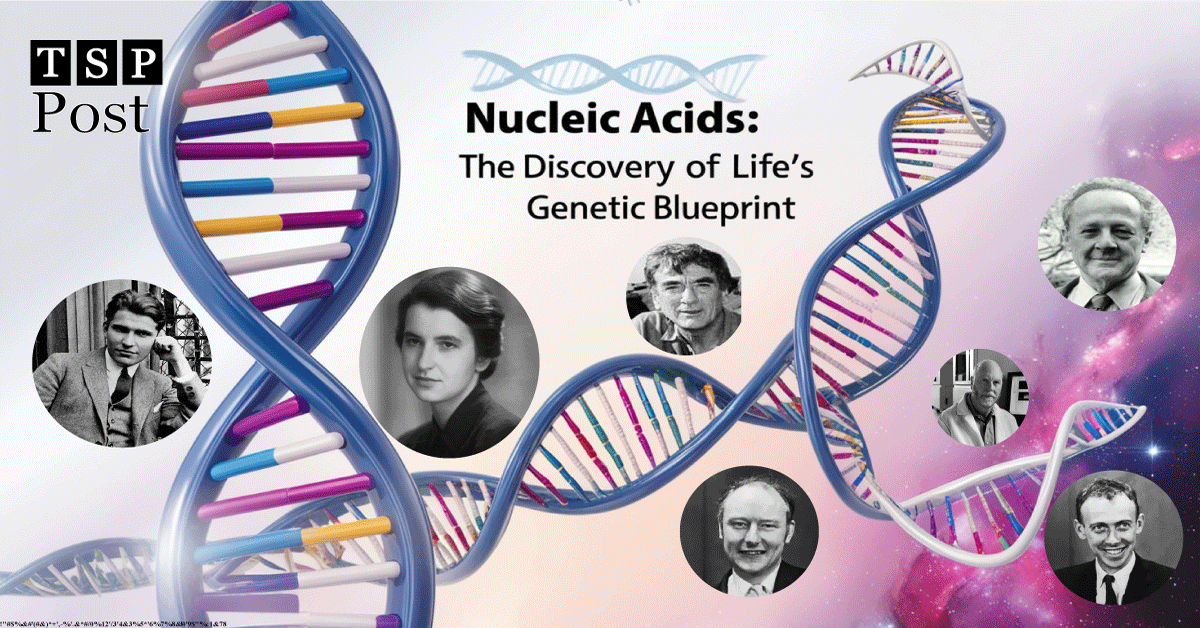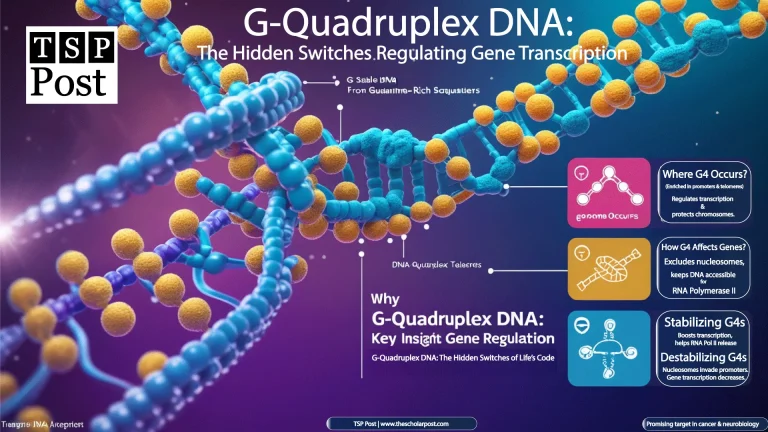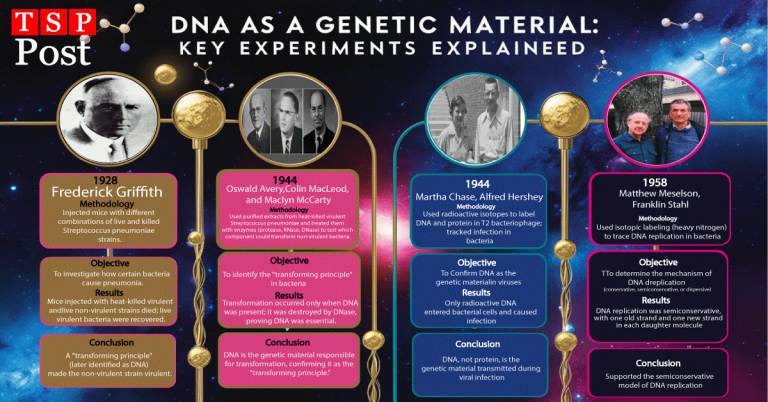Nucleic Acids: The Discovery of Life’s Genetic Blueprint
Introduction of Nucleic Acids
History couldn’t retain the greatness of life sciences without the discovery of nucleic acids in the form of DNA and RNA. It opened a completely new era for understanding genetics and heredity and allowed detailed study and progress in fields like molecular biology, medicine, and biotechnology. This post is going to discuss the major contributions by key scientists within the process of unveiling the mystery of nucleic acids, focusing on their experiments, findings, and resulting implications.
The Essence of Nucleic Acids
Nucleic acids are biopolymers common in all forms of life; their basic structural units are nucleotide monomers. Specifically, Two main types can be distinguished: deoxyribonucleic acid and ribonucleic acid. In particular, DNA, with its double-helix structure, is mainly located in a cell nucleus; it bears and transmits genetic information. While, RNA is usually single-stranded and is found in the nucleus and cytoplasm. It plays a role in protein synthesis and genetic function. Therefore, RNA has several types, including messenger RNA (mRNA), transfer RNA (tRNA), and ribosomal RNA (rRNA). But, each type of RNA has its own specific function.
The discovery of nucleic acids began in 1869 when Swiss chemist Friedrich Miescher succeeded in isolating a substance from the nuclei of white blood cells (WBC). Miescher called “nuclein” to the new isolated and identified substance. The 20th-century clarification came with the works of James Watson and Francis Crick on the double-helix structure of DNA, which brought about a further revolution in our knowledge of genetics and molecular biology.
The Pioneers of Nucleic Acid Discovery
Frederick Griffith: The Transforming Principle
In 1928, Frederick Griffith conducted transformation experiments with Streptococcus pneumoniae. His experiments revealed a “transforming principle” that could transfer genetic information. This pivotal finding provided early evidence that genetic material could be transferred between bacteria, laying the groundwork for future genetic research.
Oswald Avery: Deoxyribo Nucleic Acids as Genetic Material
In 1944, Oswald Avery conducted similar transformation studies on bacteria as Griffith’s. Avery demonstrated that DNA and not the protein was the genetic material and thereby established DNA as the molecule of heredity. While largely not recognized for this major discovery, Avery’s experiments changed scientific understanding in favor of DNA as genetic material.
Erwin Chargaff: Nucleic Acid Base Pairing Rules
In 1949, Erwin Chargaff conducted a detailed chemical analysis of DNA from various organisms. He discovered that the amounts of adenine (A) equaled those of thymine (T), and guanine (G) equaled those of cytosine (C). This led to the establishment of “Chargaff’s rules” for DNA base pairing, which became essential for subsequent research into DNA structure.
Rosalind Franklin: The Helical Structure of DNA
In 1952, Rosalind Franklin performed some X-ray diffraction imaging on DNA, with the aim to explain the structurenature of DNA. She succeeded in producing an image, known as Photo 51. This image disclosed mystery of helical nature of DNA. Besides her vital role in discovery of DNA, Franklin never received any recognition during her lifetime but is known today, posthumously, for her contribution to the understanding of nucleic acids structure.
The Breakthroughs of the 1950s
Hershey and Chase: DNA in Viruses
The collaborative work of Alfred Hershey and Martha Chase in 1952 further solidified DNA’s role as the genetic material. Their famous blender experiment with bacteriophages proved that DNA, not protein, is the genetic material of viruses. For their contributions, they were awarded the Nobel Prize (Physiology or Medicine) in 1969.
Watson and Crick: The Double Helix of Dexoribonucleic Acids
The watershed moment in nucleic acid research came in 1953 when James Watson and Francis Crick analyzed X-ray diffraction data (photo 51) and Chargaff’s rules (ratio of A =T and C = G). Based on these data they constructed a model of DNA. Their constructed DNA Model helped them to understand the double-helix structure of DNA, crucial for its replication and role in heredity. Their findings earned them the Nobel Prize in Physiology or Medicine in 1962.
Meselson and Stahl: Semi-Conservative Replication of Nucleic Acids
In 1958, Matthew Meselson and Franklin Stahl conducted a density gradient centrifugation experiment on DNA. The aim of these experiments to reveal that DNA replication is semi-conservative. According to their conclusion that each new DNA molecule consists of one old strand and one newly synthesized strand, further elucidating the mechanics of DNA replication.
Summary of Key Contributions to DNA Research
At the end of this section, we summarize the important milestones of DNA research, referring to influential scientists and their ground-breaking discoveries. Frederick Griffith’s transformation experiments in 1928 provided the first indication of genetic material transfer. Watson and Crick’s discovery of the double-helix structure in 1953 was another great milestone. Each of these discoveries played a crucial role in understanding the structure and function of DNA. However, we should always remember figures like Rosalind Franklin and Erwin Chargaff. Their valuable work provided important insights into the formation of DNA mode, consequently laid the foundation of modern molecular biology. Subsequently, this table shows how such basic studies laid the ground for further genetics and eventually biotechnology, which completely rearranged our understanding of heredity and genetic information.
Pioneers of Molecular Biology: Key Discoveries in Nucleic Acid Research
A summary of pivotal breakthroughs by key scientists in nucleic acid research that shaped modern genetics (Table 1).
| Scientist | Breakthrough Contribution | Key Findings | Significant Conclusions | Methodology Overview | Year of Discovery |
| Frederick Griffith | Transformation Experiments with Streptococcus pneumoniae | Demonstrated the transfer of genetic information | Evidence that genetic material can be transferred | Griffith used both live and heat-killed strains of bacteria to observe how live strains could acquire characteristics from dead ones, indicating a ‘transforming principle.’ | 1928 |
| Phoebus Levene | Identification of Nucleotide Components | Differentiated structural features of DNA and RNA | Clarified distinctions between DNA and RNA | Levene employed chromatography to identify nucleotide components and outlined the structure of nucleotides, emphasizing their roles in DNA and RNA. | 1929 |
| Oswald Avery | Transformation Studies on Bacteria | Confirmed DNA as the genetic material | DNA is responsible for heredity | Avery conducted transformation experiments using enzyme treatments to isolate DNA as the ‘transforming principle,’ conclusively identifying it as the genetic material. | 1944 |
| Erwin Chargaff | Chemical Analysis of DNA | Discovered adenine pairs with thymine and guanine with cytosine | Established ‘Chargaff’s Rules’ for base pairing | Chargaff analyzed DNA samples and measured base composition, leading to the formulation of rules that govern nucleotide pairing in DNA. | 1949 |
| Rosalind Franklin | X-ray Diffraction Imaging of DNA | Provided evidence for DNA’s helical structure | Contributed to understanding DNA structure | Franklin captured high-resolution X-ray diffraction images, particularly Photo 51, which revealed critical information about DNA’s helical shape. | 1952 |
| Watson & Crick | Analysis of X-ray Data to Model DNA | Discovered the double-helix structure of DNA | DNA is a double helix, essential for replication | Utilizing Franklin’s data, Watson and Crick constructed a physical model of DNA, elucidating how its structure relates to genetic function and replication. | 1953 |
| Matthew Meselson & Franklin Stahl | Density Gradient Centrifugation Experiments | Demonstrated semi-conservative DNA replication | Each DNA molecule consists of one old and one new strand | They employed isotopes to trace the process of DNA replication, confirming that each new DNA molecule retains one original strand and one newly synthesized strand. | 1958 |
| Craig Venter | Key Role in Human Genome Sequencing | Produced the first draft of the human genome | Opened the era of genomics and personalized medicine | Venter utilized high-throughput sequencing technologies to map the entire human genome, revolutionizing the field of genomics and advancing medical research. | 2001 |
Advancements in Nucleic Acids Particularly RNA Research
Severo Ochoa: Enzymatic Synthesis of RNA
In 1959, Severo Ochoa contributed to understand “transcription phenomenon” of nucleic acids through his enzymatic synthesis of RNA. Specifically, he discovered RNA polymerase, the enzyme responsible for RNA synthesis. Moreover, his experimentconfirmed that RNA can be synthesized in vitro. As a result of his groundbreaking work, His work earned him the Nobel Prize in Physiology or Medicine in the same year.
Nirenberg and Brenner: Cracking the Genetic Code
In the 1960s, Marshall Nirenberg and Sydney Brenner made significant strides in understanding the genetic code. This important work laid the foundation of mRNA mediated Translation process i.e., mRNA codons direct protein synthesis. Nirenberg’s conducted expirements on synthetic RNA that revealed that the codon UUU codes for amino acid “phenylalanine”. Brenner’s work further proved that mRNA carries the genetic code to the cellular organelle, “ribosomes”, which is essential for protein synthesis. Both Nirenberg and Brenner earned Nobel Prizes in 1968 and 2002, respectively.
Thomas Cech: The Catalytic Properties of RNA
Thomas Cech made a groundbreaking discovery in 1982 by studying RNA splicing in Tetrahymena. He identified the catalytic properties of RNA, known as ribozymes. This discovery challenged the belief that only proteins could serve as enzymes. His discovery earned him the Nobel Prize in Chemistry in 1989.
Summary of Key Contributions to RNA Research
The following section underscores some of the major findings about RNA, starting with some important discoveries by leading scientists. The journey began with Severo Ochoa’s discovery of RNA polymerase in 1959. Subsequently, this discovery made it possible to synthesize RNA in vitro.The table then goes on to outline how our knowledge of RNA as a genetic material came into being. In the 1960s, Marshall Nirenberg and Sydney Brenner deciphered the genetic code and the role of mRNA in protein synthesis. More recently, Thomas Cech discovered RNA enzymes, also known as ribozymes. This added RNA to the list of biological catalysts. These findings, along with many others, expanded our understanding of RNA’s functions within the cell. They also enabled technologies like CRISPR-Cas9 gene editing.
Key Scientific Contributions to RNA and Genetic Code Understanding
| Scientist | Breakthrough Contribution | Key Findings | Significant Conclusions | Methodology Overview | Year of Discovery |
| Severo Ochoa | Enzymatic Synthesis of RNA | Identified RNA polymerase, enabling in vitro RNA synthesis | RNA can be synthesized in vitro | Ochoa isolated RNA polymerase and demonstrated its function in catalyzing the synthesis of RNA from DNA templates, leading to a deeper understanding of transcription. | 1959 |
| Marshall Nirenberg | Synthetic RNA Experiments to Decode the Genetic Code | Discovered the first codon (UUU) for phenylalanine | mRNA codons direct protein synthesis | Nirenberg utilized synthetic RNA to determine which amino acids correspond to specific codons, establishing a fundamental understanding of the genetic code. | 1961 |
| Sydney Brenner | Study of mRNA in Protein Synthesis | Confirmed mRNA carries genetic information to ribosomes | mRNA is essential for protein synthesis | Brenner’s investigations revealed how mRNA serves as a messenger between DNA and ribosomes, which translates the genetic code into proteins. | 1961 |
| Thomas Cech | RNA Splicing in Tetrahymena | Found catalytic properties of RNA (ribozymes) | RNA challenges the ‘protein-only’ model | Cech’s research on RNA splicing in Tetrahymena led to the discovery of ribozymes, proving that RNA can have enzymatic functions and challenging existing paradigms. | 1982 |
| Jennifer Doudna | Development of CRISPR-Cas9 Gene Editing | Enabled precise DNA modifications | Revolutionized genetic engineering | Doudna’s innovation of the CRISPR-Cas9 technology allows for targeted editing of genomic sequences, significantly impacting genetic research and biotechnology. | 2012 |
Modern Contributions and Innovations of Nucleic Acids
Craig Venter: Pioneering Human Genome Sequencing and Advances in Nucleic Acid Research
By the end of the millennium, Craig Venter was leading in the race for human genome sequencing. In 2001, he introduced the first working draft of the human genome sequence, and ever since then, genomics and personalized medicine have thrived. Consequently, this work revolutionized understanding in genetics and opened up avenues in innovative fields.
CRISPR Revolution: Nucleic Acid Editing by Doudna and Charpentier
Gene editing is one of the most important discoveries of this century. In this regard, Jennifer Doudna and Emmanuelle Charpentier conducted experiments using the CRISPR-Cas9 system for gene editing in 2012. They developed a revolutionary technique that allows for precise editing of DNA as well. Their groundbreaking work earned them the Nobel Prize in Chemistry in 2020. This demonstrates the ongoing importance of nucleic acids. Nucleic acids continue to play a vital role in modern science and medicine.
Apology for Oversight in Nucleic Acids Discovery
Before concluding my post, I sincerely apologize for an oversight in my current blog. I neglected to mention several significant contributions from pioneering scientists. Their groundbreaking work is essential to our understanding of the field. I appreciate your understanding as I work to correct this. I will strive to rectify it in future discussions.
Conclusion: Nucleic Acids and Their Significance
It became obvious that numerous scientists have contributed significantly to the discovery of nucleic acids. Through, their innovative experiments and groundbreaking discoveries played a crucial role in this journey. Consequently, their work has profoundly shaped our understanding of these essential molecules.. For instance, Griffith’s early experiments marked the beginning of DNA and RNA research. Later, the CRISPR revolution further advanced this field. In fact, each scientist contributed to unveiling the complex mechanisms of DNA and RNA. As a result, exploring nucleic acids continues to reveal their potential. Moving forward, these foundational contributions will guide future research. Moreover, they will also drive advancements in molecular biology.







